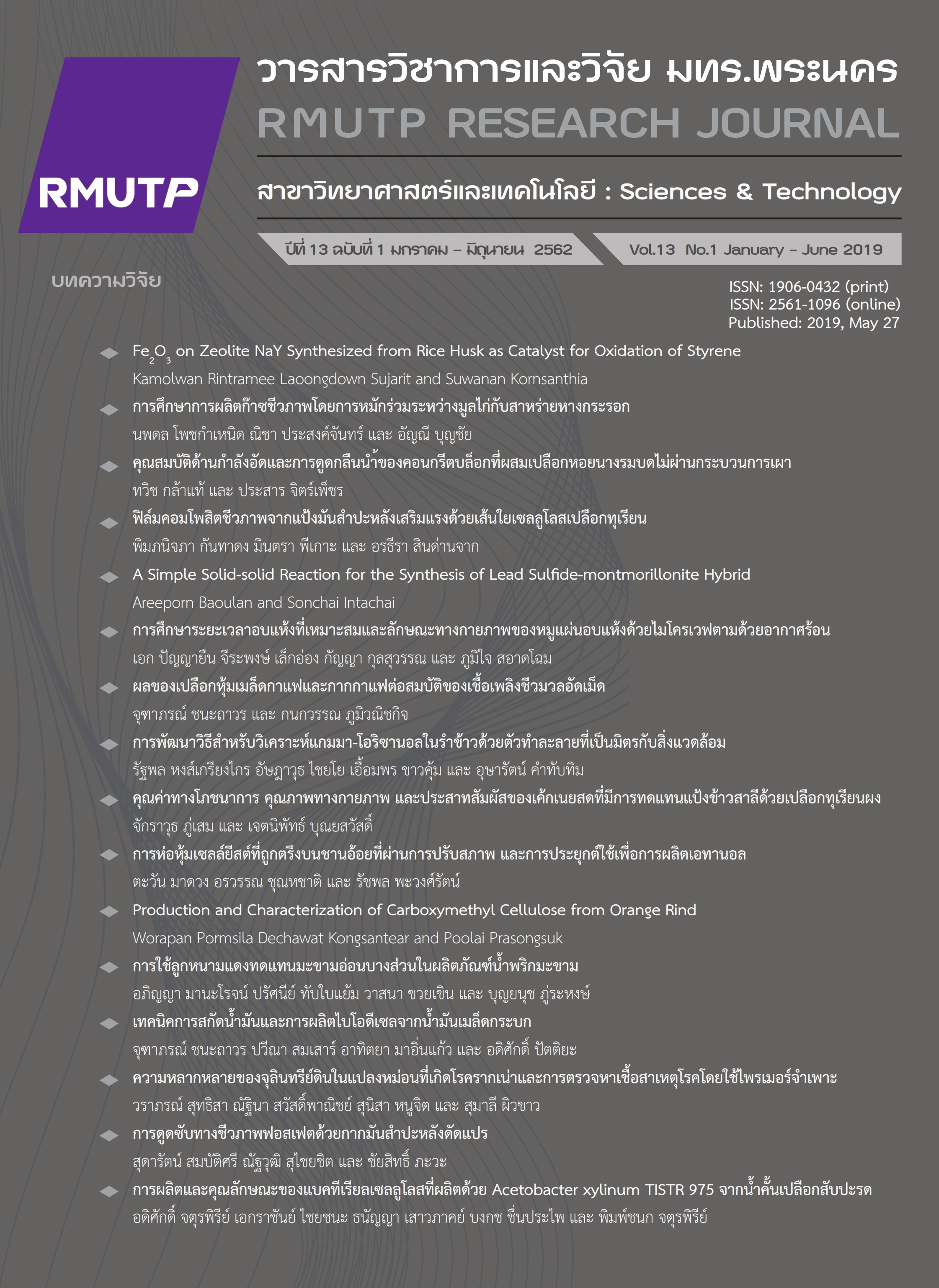การศึกษาระยะเวลาอบแห้งที่เหมาะสมและลักษณะทางกายภาพของหมูแผ่นอบแห้งด้วยไมโครเวฟตามด้วยอากาศร้อน
Main Article Content
บทคัดย่อ
งานวิจัยนี้มีวัตถุประสงค์เพื่อหาระยะเวลาอบแห้งที่เหมาะสมของการอบแห้งหมูแผ่นด้วยไมโครเวฟตามด้วยอากาศร้อน หาความสิ้นเปลืองพลังงานจำเพาะที่ใช้ในการอบแห้ง ศึกษาลักษณะทางกายภาพของหมูแผ่นอบแห้งด้านสีและความแข็ง และประเมินคุณภาพของหมูแผ่นอบแห้งด้านประสาทสัมผัส โดยอบแห้งหมูแผ่นขนาดพื้นที่ 50×50 ตารางมิลลิเมตร หนา 1.3 และ 2.2 มิลลิเมตร ด้วยไมโครเวฟที่กำลัง 160,320,480,640 และ 800 วัตต์ แล้วอบแห้งต่อด้วยอากาศร้อนที่ 110 องศาเซลเซียส จนความชื้นของหมูแผ่นต่ำกว่าร้อยละ 20 มาตรฐานแห้ง จากผลการทดลองพบว่า ระยะเวลาอบแห้งด้วยไมโครเวฟซึ่งทำให้ได้หมูแผ่นอบแห้งที่ไม่เกิดรอยไหม้อยู่ระหว่าง 50-600 วินาที โดยขึ้นอยู่กับระดับกำลังไมโครเวฟ และระดับความหนาหมูแผ่น และพบว่า ในช่วงการอบแห้งด้วยอากาศร้อน หมูแผ่นหนา 1.3 และ 2.2 มิลลิเมตร ใช้ระยะเวลาอบแห้ง 30 และ 45 นาที ตามลำดับ ระดับกำลังไมโครเวฟไม่มีผลต่อค่าสีแดง (ค่า a) ค่าสีเหลือง (ค่า b) ความแข็งของหมูแผ่นอบแห้ง และความสิ้นเปลืองพลังงานที่ใช้ในการอบแห้งอย่างมีนัยสำคัญทางสถิติ (P>0.05) ระดับความหนาหมูแผ่นมีผลต่อค่าความสว่าง (ค่า L) ค่าสีเหลือง (ค่า b) ความแข็งของหมูแผ่นอบแห้ง และความสิ้นเปลืองพลังงานที่ใช้ในการอบแห้งอย่างมีนัยสำคัญทางสถิติ (P>0.05) นอกจากนี้ยังพบว่า หมูแผ่นอบแห้งที่ได้จากงานวิจัยนี้มีคะแนนด้านประสาทสัมผัสใกล้เคียงกับหมูแผ่นอบแห้งที่จำหน่ายในท้องตลาด
Article Details
เอกสารอ้างอิง
[2] Office of Agricultural Economics. (2018, May 19). Thailand import and export statistics [Online]. Available: https://oldweb.oae.go.th/oae_report/export_import/export.php
[3] A. Arnarson. (2018, May 19). Pork 101: nutrition facts and health effects [Online]. Available: https://www.healthline.com/nutrition/foods/pork
[4] W. Kaensup. (2018, May 19). Microwave vacuum rotary drum dryer [Online]. Available: https://www.kmutt.ac.th/rippc/best1.htm
[5] S. Paengkanya, “Microwave-vacuum drying of Peeled longan,” M.Eng. thesis, Dept. Energy Tech., King Mongkut's University of Technology Thonburi, Bangkok, Thailand, 2010.
[6] G.A. Olatunde, G.G. Atungulu and D.L. Smith, “One-pass drying of rough rice with an industrial 915 MHz microwave dryer: quality and energy use consideration,” Biosystems Engineering, vol. 155, pp. 33-43, Mar. 2017.
[7] H. Pu, Z. Li, J. Hui and G.S.V. Raghavan, “Effect of relative humidity on microwave drying of carrot,” Journal of Food Engineering, vol. 190, pp. 167-175, Dec. 2016.
[8] G. Cuccurullo, L. Giordano, A. Metallo and L. Cinquanta, “Drying rate control in microwave assisted processing of sliced apples,” Biosystems Engineering, vol. 170, pp. 24-30, Jun. 2018.
[9] R.L. Monteiro, J.V. Link, G. Tribuzi, B.A.M. Carciofi and J.B. Laurindo, “Microwave vacuum drying and multi-flash drying of pumpkin slices,” Journal of Food Engineering, vol. 232, pp. 1-10, Sep. 2018.
[10] T. Basak and B.S. Rao, “Theoretical analysis on pulsed microwave heating of pork meat supported on ceramic plate,” Meat Science, vol. 86, no. 3, pp. 780-793, Nov. 2010.
[11] C. Jouquand, F.J. Tessier, J. Bernard, D. Marier and J.C. Laguerre, “Optimization of microwave cooking of beef burgundy in terms of nutritional and organoleptic properties,” LWT - Food Science and Technology, vol. 60, no. 1, pp. 271-276, Jan. 2015.
[12] A. Chinthammit, “Development of drying process of carrot and chicken by combination of air drying and microwave heating,” M.S. thesis, Dept. Food Science & Tech., Kasetsart University, Bangkok, Thailand, 2003.
[13] K. Rattanaphitakkul, “Influence of dehydration processes on quality changes and antioxidant activity of dried banana,” M.S. thesis, Dept. Food Science & Tech., Naresuan University, Phitsanulok, Thailand, 2007.
[14] S. Tirawanichakul, S. Lamaepae and Y. Tirawanichakul, “Combined infrared/microwave and hot air drying for jackfruit: kinetics, quality and sensory analysis,” Burapha Science Journal, vol. 17, no. 1, pp. 117-129, Jan. 2012.
[15] O. Buntawong, S. Pikasem and W. Intanun. (2018, May 19). Effect of processing methods on product quality of puffed job’s tears snack [Online]. Available: https://journal.rmutp.ac.th/wp-content/uploads/2014/08/Special-Food-Agriculture-Biotechnology-27.pdf
[16] T.Q. Le and W. Jittanit, “Optimization of operating process parameters for instant brown rice production with microwave-followed by convective hot air drying,” Journal of Stored Products Research, vol. 61, pp. 1–8, Mar. 2015.
[17] AOAC, Official Methods of Analysis of AOAC International. Virginia: Association of Official Analytical Chemists, 2012.
[18] P. Kongpoopha, U. Tapai and P. Sa-adchom, “Effect of drying temperatures on charcoal briquettes drying using a combined solar energy and far-Infrared radiation dryer, and a far-infrared radiation dryer,” RMUTP Research Journal, vol. 10, no. 1, pp. 77-93, Mar. 2016.
[19] K. Kanlaya, P. Sa-adchom and T. Swasdisevi, “Drying of ground fish slices using superheated steam combined with hot air,” RMUTP Research Journal, vol. 8, no. 1, pp. 51-63, Mar. 2014.
[20] P. Sa-adchom, T. Swasdisevi, T. Thomthong, P. Samuttharin and S. soponronnarit, “Drying of ground fish slices using superheated steam,” RMUTP Research Journal, vol. 7, no. 2, pp. 74-86, Mar. 2013.


